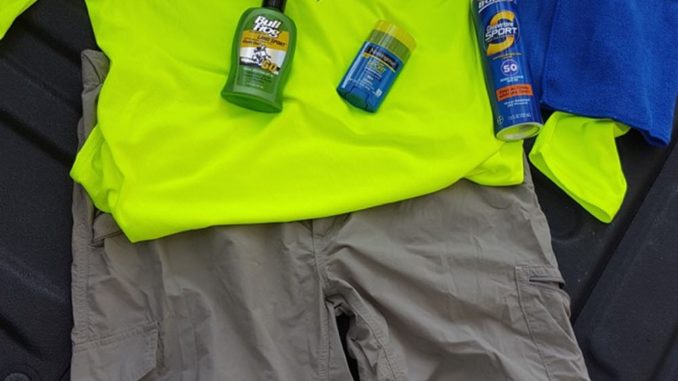
Cover your skin with clothing, sunscreen
To his wife’s prodding about wearing some sun protection, an inshore angler who loved to wade-fish once said, “I don’t need any sunscreen. I don’t get burned; it just goes straight to tan.”
The shirtless fellow’s whole upper body was as red as a beet, and even though his color transformation was easy for everyone around him to see, he just didn’t get it.
And he’s not alone.
Sunburn can sneak up on us all if we don’t take necessary precautions. It can ruin a multi-day fishing trip, and it can just as easily ruin several more days for anyone in the aforementioned angler’s shoes. It can have long-lasting consequences far worse than a simple sunburn. Fortunately, a little preparation can help avoid the self-inflicted torture.
Dr. Jason Fendlow of Greenville, S.C., a retired dermatologist and avid fisherman, said the No. 1 tip to avoid scorching your skin is to not expose it to the sun. That doesn’t mean we have to stay indoors, but taking your shirt off is a definite no-no for anyone trying to avoid a sunburn.
“Plenty of companies make lightweight shirts that offer great sun protection, and even when wearing the long-sleeved versions, your skin is staying cooler than if it was exposed to the sun for more than just a few minutes,” he said.
Another precaution is to wear a hat. While it keeps the sun off your face, it also keeps sun off your scalp. Many anglers, Fendlow said, protect every part of their body except the scalp. Unless they have very thick hair, anglers should avoid visors.
“And floppy hats are better than ball caps,” he said. “Ball caps don’t protect your neck or your ears. But if you insist on wearing ball caps, at least cover up with a neck gaiter. They are made of the same high-tech material as today’s fishing shirts, so they’re not bulky or uncomfortable, and they will keep you from burning just fine,” he said. “You can also pull them up to cover your nose, face and ears.”
Pants also come in the same materials, and like today’s fishing shirts and neck gaiters, they dry quickly when wet and offer better sun protection that anything else. Fishing gloves are also available to keep your hands from burning. Check out the shirts, ball caps and neck gaiters on Carolina Sportsman’s website at www.sportsmangear.com.
As a dermatologist, Fendlow has seen a number of anglers who likely avoided skin cancer with these tips, but some did develop skin cancer in an unlikely place.
“Many anglers fish with sandals or barefooted, and even those who slather on sunscreen often forget about their feet,” he said. “I’ve seen some badly sunburned feet, and I’ve removed plenty of questionable spots from the feet of anglers.”
Fendlow said even anglers who don’t keep their skin covered can do themselves a favor by using sunscreen, and the higher the SPF rating, the better. The problem with sunscreen, he said, is that many anglers don’t apply it early or often enough.
“I had a patient that was a full-time fishing guide for 40 years. I treated him for something unrelated to skin cancer,” he said. “Even though he would often see me later in the day after fishing, his skin was never red, and he was a fair-skinned man. I asked him how he avoided getting sunburned, and he said his method was foolproof.”
That patient told Fendlow that he used sweat-proof Bull Frog gel with an SPF of 50, and he only applied it once each day.
“He said the trick was applying it before he ever got sweaty. He applied it before leaving his house, even if it was 5 a.m.,” Fendlow said. “He told me that he would apply it that early, then wash it off when he got home every night. On the rare occasion that he forgot, he said he would use a towel on his boat to thoroughly dry the sweat, then apply the sunscreen, but he said he often got burned when doing that. He said it was because it wouldn’t properly stick to him with even a little sweat.
“I think it’s more likely because he put the sunscreen on after his skin was already exposed too long, but I do think there is something to be said for applying it before sweating. No matter how waterproof or sweat-proof any of them say they are, that doesn’t mean they mix with sweat well on the day’s initial application.”




Be the first to comment